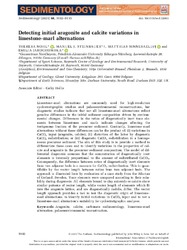Detecting initial aragonite and calcite variations in limestone–marl alternations
DOI: https://doi.org/10.1111/sed.12885
Persistent URL: http://resolver.sub.uni-goettingen.de/purl?gldocs-11858/9731
Persistent URL: http://resolver.sub.uni-goettingen.de/purl?gldocs-11858/9731
Nohl, Theresa; Steinbauer, Manuel J.; Sinnesael, Matthias; Jarochowska, Emilia, 2021: Detecting initial aragonite and calcite variations in limestone–marl alternations. In: Sedimentology, Band 68, 7: 3102 - 3115, DOI: 10.1111/sed.12885.
 |
Dokument öffnen: |
Limestone–marl alternations are commonly used for high‐resolution cyclostratigraphic studies and palaeoenvironmental reconstructions, but diagenetic studies indicate that not all limestone–marl alternations reflect genuine differences in the initial sediment composition driven by environmental changes. Differences in the ratios of diagenetically inert trace elements between limestones and marls indicate changes affecting the terrigenous fraction of the precursor sediment. Contrarily, limestone–marl alternations without these differences can be the product of: (i) variations in CaCO3 input (aragonite, calcite); (ii) distortion of the latter by diagenetic CaCO3 redistribution; or (iii) diagenetic CaCO3 redistribution in a homogeneous precursor sediment. The aim of this study is to provide a method to differentiate these cases and to identify variations in the proportion of calcite and aragonite in the precursor sediment composition. The model of differential diagenesis assumes that the concentration of diagenetically inert elements is inversely proportional to the amount of redistributed CaCO3. Consequently, the difference between ratios of diagenetically inert elements from two adjacent beds is a measure for CaCO3 redistribution. This is quantifiable by the vector length between ratios from two adjacent beds. The approach is illustrated here by evaluation of a case study from the Silurian of Gotland, Sweden. Trace elements were compared according to their solubility during diagenesis. All elements bound to clay minerals or calcite show similar patterns of vector length, while vector length of elements which fit into the aragonite lattice, and are diagenetically mobile, differ. The vector length approach provides a tool to test the diagenetic origin of limestone–marl alternations, to identify initial variations in CaCO3 input and to test a limestone–marl alternation’s suitability for cyclostratigraphic analyses.
Statistik:
ZugriffsstatistikSammlung:
Schlagworte:
Aragonitecalcite
carbonate sedimentology
limestone–marl alternation
palaeoenvironmental reconstruction
This is an open access article under the terms of the Creative Commons Attribution‐NonCommercial‐NoDerivs License, which permits use and distribution in any medium, provided the original work is properly cited, the use is non‐commercial and no modifications or adaptations are made.

